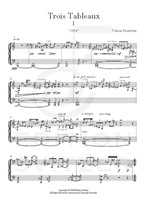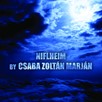
Trois Tableaux
Composer: Tobias Broström
Instrument: Marimba
Level: Advanced
Published: 2009
Price: €20.00
Item details
-
Description +
-
Duration: 10 min.
Trois Tableaux gets its inspiration from the music of Igor Stravinsky's three ballets The Firebird (1910), Petrushka (1911) & The Rite of Spring (1913).
The first part of the piece flirts with the introduction of The Firebird and is based on the harmonic ideas from the so called Petrushka chord, a bitonal chord that is combination of two mayor triads that also occurs in The Firebird (C and F#). Later on a melodic unpretentious diatonic folk-tune motive enters superimposed, in a typical Stravinsky manner, on a chord in a different key. This motive also occurs in the last movement.
Movement two is played attacca and a new tableaux/picture or scenography is displayed. Its main section – volante – could lead ones thoughts to the “flying” flute playing in the introduction of Petrushka. The last movement has a distinct repeated theme on which the whole movement leans. It's written in 7/8 and has the character of folk-tune dance. Trois Tableaux is dedicated to Johan Bridger.
-
-
Instrumentation +
-
Marimba (5-octave)
-
-
Watch+
-
About the composer +
-
Tobias Broström was born in 1978 in Helsingborg, Sweden. Following four years of percussion studies at the Malmö Academy of Music, he embarked on the pursuit of a Master’s degree in composition, studying with the Swedish composer Rolf Martinsson and the Italian composer Luca Francesconi.
Broström has composed chamber opera and various chamber music, but during the last years he has mainly focused on orchestral writing in works such as La Danse, Transit Underground, Crimson Skies, Crimson Seas, Kaléidoscope, Violin Concerto, Arena – Percussion Concerto No. 1, Piano Concerto – Belle Epoque, Samsara, Cello Concerto and Lucernaris – Concerto for Trumpet, Live Electronics & Orchestra, which was composed for Håkan Hardenberger. Numerous soloists, conductors, ensembles and orchestras, including, Robin Ticciati, Michael Sanderling, John Storgårds, Anna Larsson, Karen Gomyo, Thomas Søndergård, Andrew Manze, Dima Slobodeniouk, Johannes Gustavsson, Per Tengstrand, Colin Currie, Mats Rondin, Tõnu Kaljuste, Simon Preston, Johan Bridger, Hugo Ticciati, Jaime Martín, BBC Symphony, Detroit Symphony, Dresdner Philharmonie, BBC Philharmonic, Komische Oper Berlin, Symphonieorchester des Bayerischen Rundfunks, Estonian National Orchestra, BBC Scottish Symphony Orchestra, BBC Wales, Gävle SO, Helsingborg SO, Trondheim SO, Malmö SO, Sinfonieorchester St. Gallen, Vogtland Philharmonie, Oviedo SO, NorrlandsOperans SO, Aurora Chamber Orchestra, Brooklyn Rider, Musica Vitae, Third Coast Percussion Quartet, Malleus Incus, Essens:1 and Gageego have performed his works. Tobias’ music have been performed throughout Europe, the USA and Asia.
Between 2006 – 2009 Tobias was Composer-in-Residence with the Gävle Symphony Orchestra under principal conductor Robin Ticciati, resulting in two new orchestral works each year. Two of these, Crimson Seas & Lucernaris were selected by Swedish Radio to represent Sweden in the European Broadcasting Union’s International Rostrum of Composers in 2007 & 2009. In autumn 2008 his Arena – Solo Version was picked out to be performed at the 52nd International Festival of Contemporary Music at the Venice Biennale and his orchestral piece Transit Underground was nominated for best orchestral piece of the year by Swedish Music Publishers’ Association. In 2010 Lucernaris was nominated for best orchestral piece and in 2012 La Danse was nominated.
-
-
Reviews +
-
Review (Percussive Notes, March (58) 2012)
Looking to add ten minutes of intensity to your next solo concert? In this three-movement work, Tobias Broström provides advanced marimbists with another opportunity to perform music that is modeled after the early compositional style of Stravinsky.
The three “pictures” that make up this composition are loosely based upon thematic material from “The Firebird,” “Petrushka,” and “The Rite of Spring.” Each movement is named for the corresponding year of each ballet, in chronological order (1910, 1911, and 1913). The opening of the first movement is similar to that of the corresponding ballet and deals with harmonic content from the “Petrushka chord.” The second movement may bring thoughts of the opening flute passages in “Petrushka.” The last movement is highly rhythmic, based around a repeated theme and has the character of a folk-tune dance.
Single independent (inside and outside), double vertical, double lateral (inside and outside), triple lateral (inside and outside), and single alternating strokes are all used here. The writing is non-idiomatic at times, and requires advanced technique. This is for seasoned marimbists who are looking for a challenging addition to their repertoire.
It is often a gamble for a composer to attempt the compositional style of another—especially one of the most famous in history. Composers should not completely limit themselves to replicating what has already been done, but rather strive to take the ideas and mesh them with their own. As a percussionist/ composer, Broström effectively utilizes the marimba as an outlet for this intense musical expression.—T. Adam Blackstock
-
-
Credits +
-
Front Cover graphics and layout: Tobias Broström
Engraving: Tobias Broström/Johan Svitzer
Printed in Copenhagen, Denmark
Copyright © Edition Svitzer
www.editionsvitzer.com
-




